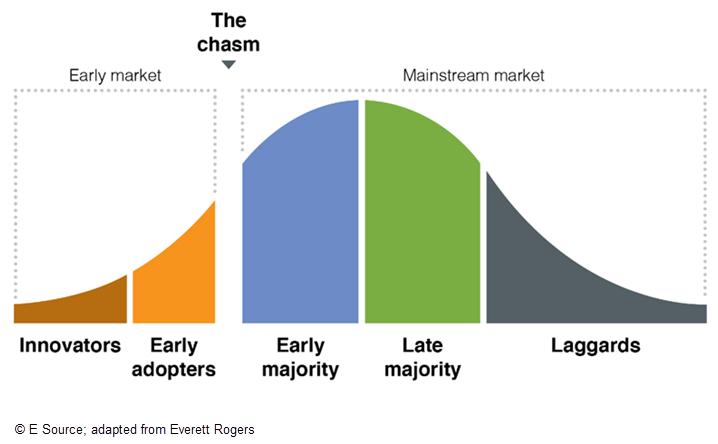5 innovative technologies utilities should keep an eye on in 2024
Our tech roundup webinars keep utilities up to date on the latest developments in efficiency, load management, and decarbonization technologies. At the Winter 2023 Tech Roundup, we highlighted nine technologies or concepts we think define the emerging technology opportunity for the start of 2024.
In this blog post, we’ll highlight five of the most promising technologies from the event. Members of the E Source Technology Assessment Service can watch the recording or read the highlights report, 5 standout technologies from the Winter 2023 tech roundup, for a deeper dive into each technology. Not a member and want to learn more? Contact us to get access.
Occupancy-based HVAC controls
Business owners don’t want the heat or cooling to shut off in a room where an employee is working late. Occupancy-based HVAC controls solve this problem by detecting people in rooms and controlling heating or cooling accordingly, even when it’s outside of scheduled hours.
While it’s not a new technology, we think utilities should take another look at these controls. Recent case studies show that occupancy-based HVAC control upgrades can increase energy savings when they’re combined with lighting sensors.
Like other HVAC controls, occupancy-based HVAC controls save energy by reducing runtime and fan speeds. But occupancy-based HVAC controls provide better comfort in large buildings with scattered occupancy.
Utilities can combine this technology with occupancy-based lighting sensors that many customers, including small and midsize businesses, already use or plan to install.
Next-generation heat pumps
One of the reasons heat pumps haven’t reached mainstream market adoption is because of marketplace gaps in the available models. But new innovations in heat pump technology are filling those gaps.
We’re seeing more and more innovative designs filling niches in the heat pump market. This can help heat pumps move past the early adoption phase and into the mainstream market. If heat pumps don’t move past the early adoption phase, the technology could fall into what Everett Rogers calls the chasm.
Rogers’s diffusion of innovation curve and the chasm that heat pumps need to cross
Initiatives like the US Department of Energy’s Cold Climate Heat Pump Challenge, which had the goal to speed up the adoption of ductless heap pumps in cold climates, help get heat pumps into the mainstream market. Because a key challenge to the wider adoption of heat pumps is performance in cold weather, the Department of Energy challenge required manufacturers to get government support to design, test, and scale up manufacturing for the new heat pump models. The first commercialized models will hit the market early in 2024.
Smart home energy management systems
ENERGY STAR launched its SHEMS program in 2019. Smart home energy management systems (SHEMSs) are platforms that combine smart home hardware and software in a way that should result in energy efficiency savings.
We recommend utilities pilot SHEMS products. ENERGY STAR–certified SHEMS products give customers a secure platform to control all their energy and nonenergy smart home features in one convenient place. For instance, customers can manage their lighting and thermostats in the same place where they manage their door locks and security cameras.
It also influences customers to use their devices in a way that reduces energy. Utilities benefit because they can claim energy savings with low customer impact for many device categories under one program. It also enables demand response opportunities that customers otherwise wouldn’t qualify for.
SHEMS promises to turn smart homes into energy assets. If this technology can fulfill its promise, it will be a useful tool in delivering flexibility and savings to an energy grid that increasingly needs those services.
Residential ultrafast EV charging
Ultrafast Level 2 chargers refuel EVs for residential customers at their home using 19 kilowatts (kW) of power, instead of a slow Level 2 charger (3 kW) or standard Level 2 (7.7 kW).
EV owners like ultrafast Level 2 chargers because they’re used to fueling cars quickly, as they did at the gas pump. Ultrafast Level 2 chargers can help you meet customer expectations because charging with this technology is like filling a gas-fueled vehicle with gasoline at the pump.
But even low-powered home chargers present distribution problems when residential transformers can’t support the electrical capacity. And ultrafast Level 2 chargers could more than double a home’s peak power demand. Utilities will need to think fast about how they’ll incorporate these new chargers into their grids. They may need to write new rules, develop ultrafast charging standards, and introduce new managed charging programs.
Thermal energy storage
Thermal energy storage relies on phase-change materials, which release thermal energy when they change from solid to liquid and liquid to gas. While it’s not a new technology, thermal energy storage has undergone recent advancements, making it safer and more cost-effective than ever before. And it’s capable in more applications now.
Thermal energy storage is a good solution for large industrial customers, especially for refrigeration and cold storage.
Thermal energy storage freezes or superheats a medium, often phase-change materials, during off-peak hours or when there is plenty of clean energy. The stored heat or cold in the material can heat or refrigerate a building or process during peak hours when energy is more expensive. Or the system can charge or hold onto the heat or cold when prices are lower.
Recent advancements created different melting points in phase-change materials, so this technology can better help in these areas:
- Load shifting. Facilities can switch to thermal energy storage to heat or cool during peak hours.
- Energy efficiency. Especially helpful in cold climates because it can freeze the phase-change material with less energy using outside air.
- Demand response. Facilities can switch to thermal energy during demand response events, even those lasting multiple days.

